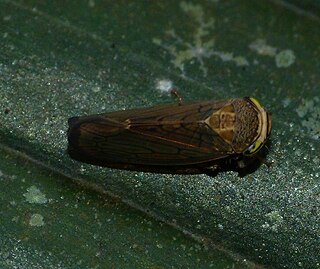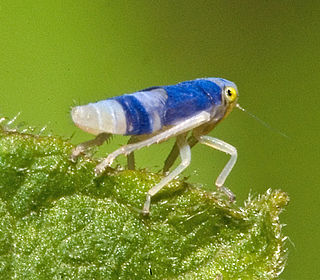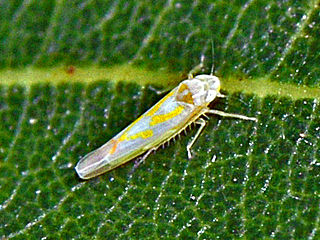Nirvana is a concept in Indian religious traditions.

A leafhopper is the common name for any species from the family Cicadellidae. These minute insects, colloquially known as hoppers, are plant feeders that suck plant sap from grass, shrubs, or trees. Their hind legs are modified for jumping, and are covered with hairs that facilitate the spreading of a secretion over their bodies that acts as a water repellent and carrier of pheromones. They undergo a partial metamorphosis, and have various host associations, varying from very generalized to very specific. Some species have a cosmopolitan distribution, or occur throughout the temperate and tropical regions. Some are pests or vectors of plant viruses and phytoplasmas. The family is distributed all over the world, and constitutes the second-largest hemipteran family, with at least 20,000 described species.

The common brown leafhopper is one of the most common species of Australian leafhoppers with a very wide host range. It is an important vector of several viruses and phytoplasmas worldwide. In Australia, phytoplasmas vectored by O. orientalis cause a range of economically important diseases including legume little leaf, tomato big bud, lucerne witches broom, potato purple top wilt, Australian lucerne and the insect is a possible vector of Australian grapevine yellows. O. orientalis also transmits Tobacco yellow dwarf virus to beans, causing bean summer death disease and to tobacco, causing tobacco yellow dwarf disease.

Deltocephalinae is a subfamily of leafhoppers. Deltocephalinae is the largest subfamily in the family Cicadellidae and is divided into 40 tribes, comprising over 925 genera, and over 6,700 described species.

Orosius is a genus of leafhopper in the tribe Opsiini and the subfamily Deltocephalinae. The genus was revised by Ghauri in 1966. Species can be differentiated by the shape of the aedeagus.

Euacanthellinae is a subfamily of leafhoppers, native to Australia, New Caledonia and Madagascar, and adventive in New Zealand. There are 11 described species in 4 genera. 10 species in 3 genera are native to Australia, Madagascar has a single endemic genus/species, and New Caledonia has a single undescribed species of uncertain generic placement. New Zealand has a single species, Euacanthella palustris, adventive from Australia. There are two tribes, Euacanthellini, and Sagmatini.

Kutara is a leafhopper genus belonging to the subfamily Deltocephalinae. It was previously assigned to the Selenocephalinae subfamily.

Eurymela is a genus of leafhoppers. There are seven known species, and they are found throughout mainland Australia. The two most common species are E. fenestrata and E. distincta. E. fenestrata is the type species. Species of the genus are commonly known as "Jassids". They feed on the sap of Eucalypts.

Typhlocybinae is a subfamily of insects in the leafhopper family, Cicadellidae. This is currently the second largest leafhopper subfamily based on the number of described species, but researchers believe there are so many taxa yet undescribed that it is probably the largest subfamily. Approximately 6000 species have been described to science so far.
Dayus is a genus of leafhoppers in the subfamily Typhlocybinae.

Alebrini is a leafhopper tribe in the subfamily Typhlocybinae.

Coelidiinae is a subfamily of leafhoppers in the family Cicadellidae. There are at least 8 tribes, 108 genera, and over 900 species in Coelidiinae.

Bathysmatophorinae is a small subfamily in the family Cicadellidae (leafhoppers).

Evacanthinae is a subfamily in the family Cicadellidae (leafhoppers).
Hylicinae is a subfamily in the family Cicadellidae (leafhoppers).
Mileewinae is a small subfamily in the family Cicadellidae (leafhoppers). It is closely related to Typhlocybinae and contains species that were previously part of Cicadellinae.

Archijassidae is an extinct family of leafhoppers known from the Late Triassic to the early Late Cretaceous. It is the oldest member of Membracoidea, and is considered ancestral to modern leaf and treehoppers.
Occinirvana eborea is a species of leafhopper in the subfamily Deltocephalinae. It is the only member of the genus Occinirvana and the tribe Occinirvanini, making them both monotypic taxa. O. eborea is endemic to Western Australia. It is closely related to Loralia, another genus of leafhoppers endemic to Australia.
Rubria is a genus of leafhoppers in the family Cicadellidae, the species of which are found mostly in Australia. Swedish entomologist Carl Stål described the group as a subgenus of the genus Petalocephala, but later raised it to a genus in its own right in 1966 by J.W. Evans. The genus is a distinct lineage within the family and is placed in its own tribe Rubrini.
Irena Dworakowska is a Polish entomologist who specialized in hemipterology.











